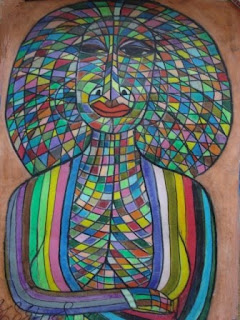
Charles Sekano in the 1980s
Born in Sophiatown, Johannesburg in 1945, Sekano’s youth was cruelly overshadowed by the consequences of apartheid. Sophiatown was destroyed by the authorities and his family forced in to tribally segregated districts within Soweto. This process of dislocation lead to the early death of his father and to his decision to flee South Africa and exile himself from the harsh and violent conditions that he found himself in.
It was in Nairobi in the 1960’s, amid the very real isolation of exile that Sekano forged himself in to both self taught artist and musician – and where he worked as a Jazz pianist in the multiracial, bars and nightclubs of this rough edged African metropolis. Here he lived life in the tradition of a romantic bohemian artist and musician, developing his own version of the three Rs – “the three Ps” – Painting, Poetry and Piano. Like Degas and Toulouse Lautrec before him – living amongst his, mostly female, subjects.

His artistic expression was and is informed by the sense of loss experienced after his family were uprooted and by the resultant severing of family bonds. Women, for Sekano, - those that he immortalises in his works - became his world and his artistic language.
In the words of Sekano in an interview from the 1980s:
“The whole idea is a symbolic relationship. Even the theme “Woman” seems to be remembering my mother, my sisters. I’m trying to live on a higher level with them because I have no communication to show that I am attached to them. They are inseparable from me. There is no border. This Woman theme is my landscape. The only piece of property I own. Woman is the only country I have.”
During his years of exile in Nairobi Sekano waged his own passionate war against the apartheid regime with paintbrush and crayon. The fact that he chose to include Caucasian women in his work was a starting point that surprised some of his peers. But for him colour itself began to symbolise freedom.
“I decided to destroy the apartheid in my thoughts by using colour, by breaking the colour bar. So I just fused everything. I made a red woman, I made a blue woman, a green woman.”
Whilst influences of Picasso and Braque’s Cubism , Toulouse-Lautrec’s and Henri Rousseau’s poster art are clear in his work, Sekano has always rooted himself in the realities of cosmopolitan urban Africa and drawn on Egyptian and San Rock art for inspiration. The nightclubs and bars of Kenya with their beautiful female clientele from diverse cultures across Africa were his subject matter and remain his inspiration. These are “spaces” where opportunism and desire intersect and coexist, often in surprising ways. Each work – be it of a single figure, a couple or a group, contains a narrative – keenly and economically observed. The story of the lure of the bright lights and the promise of escape from poverty and pain underlies many of the tableaux. Sekano is never moralistic, always humanistic – his works celebrate and preserve moments.

In 1997 Charles Sekano returned to a newly liberated South Africa with mixed feelings leaving behind a country he had grown to love, and re-entering a society that had largely forgotten him – the fate of many a returning exile.
Apart from two fine works from the late 1980s the paintings in this exhibition have been produced in the last two years and are part of a new body of work which the artist calls “House of Women”. Sekano has become fascinated with a “building block” mosaic style – where the women who have inspired him all his life are constructed from these geometric shapes referencing the notion of home and strength as well as musical notes.
Charles Sekano has exhibited widely in Kenya, Holland and Germany, Japan and the U.S.A., his most recent show was at the University of Pretoria in 2008. His works are in private collections across the world and in various museums including Volkekunde Museum, Frankfurt, and the Peabody Essex Museum, Massachusetts.
The works in this exhibition are for sale – for further information please contact Ed Cross at Ed Cross Fine Art ed@edcrossfineart.com or visit http://edcrossfineart.com/ for the complete catalogue and pricelist.
Ed Cross Fine Art thanks Simon Russell for his generous support for this exhibition.















